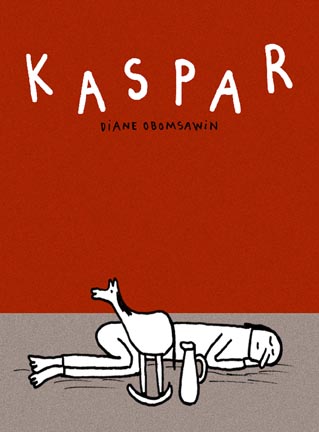
Kaspar
Drawn and Quarterly
Written and drawn by Diane Obomsawin
Jun 05, 2009
Web Exclusive
![]()
Diane Obomsawin’s inaugural graphic novel in English is Kaspar, a sadly truncated volume that unveils the life of Kasper Hauser. The Canadian filmmaker and cartoonist’s envisage of this unbelievable narrative is told frankly in comparison to the more extravagant tones already lended to Hauser by the likes of Werner Herzog and Harlan Ellison. No mention of the controversy of whether Hauser is just a snappish fraud is discussed nor is even much revealed about his death. Obomsawin favors the part of the man-child’s life where he was introduced into bourgeoisie society. After all, the other side of erudite culture studies that as well. He was an abandoned feral child found in Nuremburg, Germany, in 1828. The illiterate mute was raised in a pitch-dark cell until his mid-teens. Quickly he became a guinea pig for a salon culture that wanted to edify him and social anthropologists intrigued by this walking, talking tabula rasa. Some believed he was heir apparent to the House of Baden but sadly he was inexplicably stabbed in a garden before anyone would find out. For Obomsawin’s depiction of Hauser’s stunted, isolated life she naturally relies heavily on dreary gray scale and childlike stick figure drawings. The 96-page book’s true narrative import stems from her faculty for conveying Hauser’s frank, naïve point of view as he gauchely reacts to the new milieu foisted upon him.
As our protagonist discovers a world outside his mental and literal prison, it’s easy to become enthralled by Hauser’s spark for life. He enjoys the kinds of things many modern adults ignore or forgot they once cherished: planting beans and fruit trees, and the complexity of the heavens and snow all present themselves to Hauser as riddles to be solved. Armchair historians wanting a larger frame of reference to the shadowy figure lost in the appendix of time will come away disappointed. Obomsawin’s account is cloistered to a fault—like reading a diary without context. Her glances into Germany’s House of Baden are serviceable but not fully sketched out. Sadly, she drives home the preciousness of her noble savage with the perspicacity of a jittery carpenter. Like her subject, Obomsawin’s Kaspar is certainly filled with awe at the natural world but only scant few panels truly animate her stick figure account of Hauser’s queer existence and demise.
Author rating: 5/10
Average reader rating: 5/10
Most Recent
- Premiere: Mia Day Shares New Single “Mountain Song” (News) — Mia Day
- Tallinn Music Week, Tallinn, Estonia, April 3-7, 2024 (Review) — Virta, Musta Huone, Mari Kalkun, Sven Grünberg
- Picnic at Hanging Rock [4K UHD] (Review) —
- Joe Goddard of Hot Chip Announces New Album, Shares Video for New Song “Moments Die” (Feat. Barrie) (News) — Joe Goddard, Hot Chip
- Premiere: O Slow Shares New EP ‘Every Time I Look In The Mirror’ (News) — O Slow


Comments
Submit your comment
There are no comments for this entry yet.